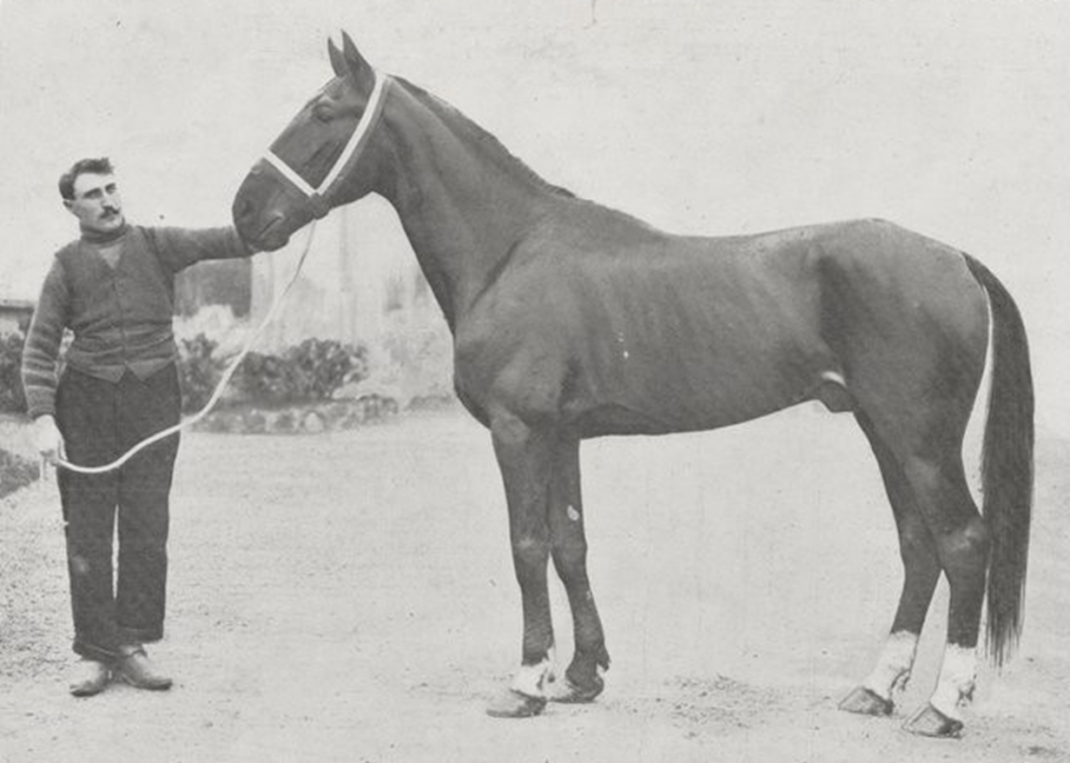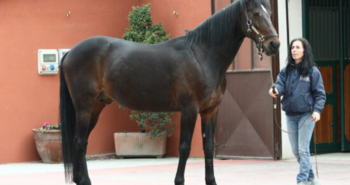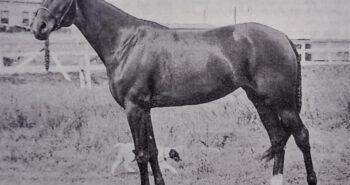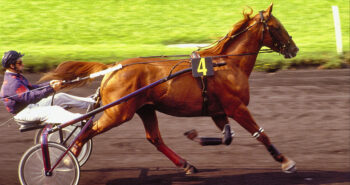The Franco-American cross is more popular than ever, and many in the US have also recognized the benefits of such a breeding. It’s often said the cross created a new breed (figuratively, not literally) in the 80s and 90s. Though there is some truth to that, the Franco-American cross was very popular much earlier than that. In fact, more than 100 years ago the French trotter (Trotteur Francais) could not compete with neither the American standardbreds nor the Russian orlov trotters. Then came a French-American cross to establish himself as the first French international star.
The story starts in Midway, Kentucky in 1880 with the birth of Mamie, one of the biggest trotting tail females. Having bought her mother Kit at an auction, her owner Philemon P. Parrish had her covered by Star Almont in 1879 and the following year the filly Mamie was born. Used on the farm at first, she was put in the training of Mike Bowerman at the age of three and was trained down to 1.39,4 (2:40) before the young filly developed a quarter crack which caused her to be taken out of training and covered at the age of three. Mamie ended up having 6 foals, one of which was Helen Leyburn by Onward, born in 1890. In 1895 she was imported to France by the American tycoon Gordon Bennett. A good trotter, she took a record of 1.28 (2:21.3) in Nice in 1897 before ending up later as a broodmare at the studfarm Haras de Janval in Seine-Infèrieure in Normandy. Always covered by the French stallion Kalmia, she first produced the mare Mamie Layburn, originally named Aitzindaria, in 1900 before delivering her full brother Bobichon 1.34 (2:31.1) the following year. Two years later the good trotter Dakota 1.28 (2:21.3) was born, but the star came in 1905 with the colt named Fred Leyburn.
According to the Hoof Beats article They all knew Mamie, by Ken McCarr, the name “Leyburn” has its origin in the novel Robert Elsmere: “Her breeder, Philemon P. Parrish, bred all of Mamie’s daughters and most of the granddaughters as well. Outside of the first foal, all of Mamie’s foals carried the word Leyburn in their name. In the book “Robert Elsmere” there were two characters carrying the names of Catherine and Rose Leyburn. This accounts for the names of the second and third foal of Mamie. As the foals with the Leyburn name did well, the practice was carried on until the entire group of Leyburns were sold to John E. Madden.”
The best in France and Europe
Fred Leyburn quickly became known as an extremely fast trotter with a speed almost unheard of in both France and Europe. On Jun 30, 1908, the three-year-old Fred Leyburn won big monte race Rouen Derby, trotting 3200 meters in 1.33,2 (virtually 2 miles in 2:29MR). Fred Leyburn didn’t just win, though, he toyed with the opposition. The runner-up, Fleurus, came home far behind in 1.36.4 (2:35.1). Had he been put under any kind of pressure, Bemecourt’s four year old race record would have been under threat. The following year, even though he was “only” 4, Fred Leyburn was ready to take on the best older horses. In the five years before WWI, Fred Leyburn and Enoch fought for supremacy on the Parisian track. The former was considered faster and maybe more capable, but the latter was always game and considered a more courageous trotter.
Fred Leyburn quickly went on to establish himself as one of the best trotters in Europe, underlined by his win at the European Championship in Baden, Austria in on Aug 14, 1910. In the race Fred Leyburn had to work hard for it in the first heat, but won it in 1.24 (2:15.1) ahead of Sir Todd and Grattan Bells, who trotted 1.24,1 (2:15.2) and 1.25,2 (2:17), respectively. In the second and final heat the French five-year-old was completely in charge, winning in 1.23,5 (2:14.2) ahead of Grattan Bells and Concurrent, who trotted in 1.24 (2:15.1), and 1.24,2 (2:15.2), respectively.
The next year he set his record of 1.21,5 (2:11.1) when he won the Prix de la Ville de Rouen, also both a French and European record. In his home country he also won three editions of both the Grand Prix de Milan and the Grand Prix du Trotting in Nice.
The Prix d’Amerique was started in 1920 and named in honor of the US assistance to France during the first World War. The origin of the race, however, goes back to 1912. After lobbying local authorities and promising to match their contribution to two annual international races, the Prix du Conseil Municipal de Paris, over 3000 meter (1 7/8 mile), and the Prix du Conseil General de la Seine, over 2500 meter (1 9/16 mile), were created. The most prestigiuous of these, and of all the races during the winter meeting, was the Prix du Conseil Municipal de Paris, and Fred Leyburn won the three editions on this in 1912, 1913 and 1914. It was then stopped the war, but when it was restarted in 1920 it was renamed Prix d’Amerique.
The famous demonstration
Though French-born, Fred Leyburn was in his home country often referred to as the American trotter (“trotteur américain”) in reference to his American dam. French breeders had not produced trotters that could compete with the best American and Russian competitors in Europe until Fred Leyburn, and the two year older Jockey, exported to Italy, came along. However, not everybody was happy. The French trotting association, La Société du Demi-Sang, was concerned that the stronger, but slightly slower, French breed was losing out to the faster, but in their eyes weaker American variant. In 1909 the association organized an exhibition at Vincennes to showcase the French breed and its advantages. In the most famous test, horses ran a test while dragging a load of 500 kg (roughly 1100 lbs). To make matters more challenging it rained heavily and the track turned into a quagmire.
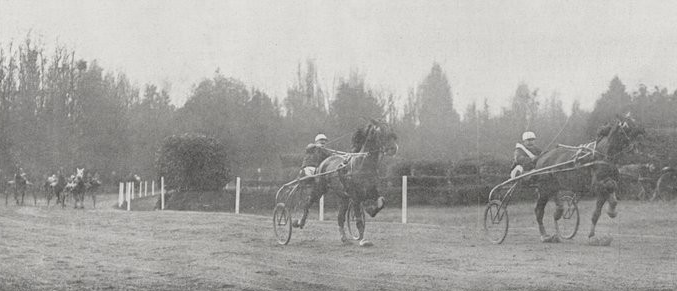
Surely perfect for the stronger French trotter, no? The test was divided into two groups, one for horses 4 years and younger and one for older trotters. Those who hoped for a demonstration of superiority of the purebred French trotter were disappointed as Fred’s older brother Dakota won the older group while Fred Leyburn himself impressed with a resounding win in his group, pulling the heavy load in a 1.47 (2:52), which turned out to be a very impressive time given the circumstances.
At stud Fred Leyburn failed to produce any top trotters – there he was in fact clearly surpassed by his brother Dakota who produced several stars, and at the age of 18, in 1923, he was exported to Algeria. Largely forgotten and not honored with any big race named after him he’s largely forgotten today. However, he should always be remembered as the first true star with a French-American pedigree and the first French born international star.
FRED LEYBURN
Bay colt born in France in 1905. Died in Algeria sometime after 1924.
Kalmia – Helen Leyburn (Onward)
1.21,5 (2:11.1) – 232,408 French francs
Breeder: Haras de Janval
Owner: Ecurie Rousseau, A Lafforgue
Trainer: Egisto Tamberi
Driver: Egisto Tamberi
Groom: –

